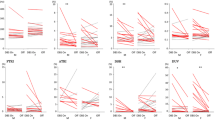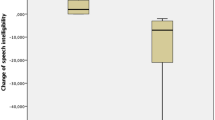Abstract
We previously reported that Parkinson’s disease (PD) patients treated with subthalamic nucleus deep brain stimulation (STN-DBS) had distinct phenotypes of speech and voice disorders: hypokinetic dysarthria, stuttering, breathy voice, strained voice, and spastic dysarthria. However, changes over time remain unclear. In the present study, 32 consecutive PD patients were assessed before and up to 1 year after surgery (PD-DBS). Eleven medically treated PD patients were also assessed (PD-Med). Speech, voice, motor, and cognitive functions were evaluated. At baseline, the incidence of hypokinetic dysarthria (63% of PD-DBS vs. 82% of PD-Med), stuttering (50% vs. 45%), breathy voice (66% vs. 73%), and strained voice (3% vs. 9%) was similar between groups. At 1 year, a slight but significant deterioration in speech intelligibility (p < 0.001) and grade of dysphonia (p = 0.001) were observed only in PD-DBS group compared with baseline. During the follow-up, stuttering (9% vs. 18%) and breathy voice (13% vs. 9%) emerged in PD-DBS and PD-Med, but strained voice (28%) and spastic dysarthria (44%) emerged only in PD-DBS. After the stimulation was stopped, strained voice and spastic dysarthria improved in most patients, while stuttering and breathy voice improved in a minority of patients. These findings indicate that the most common DBS-induced speech and voice disorders are strained voice and spastic dysarthria and that STN-DBS potentially aggravates stuttering and breathy voice. An improved understanding of these types of disorders may help detect speech and voice deteriorations during the early phase and lead to appropriate treatments.



Similar content being viewed by others
References
Aldridge D, Theodoros D, Angwin A et al (2016) Speech outcomes in Parkinson’s disease after subthalamic nucleus deep brain stimulation: a systematic review. Parkinsonism Relat Disord 33:3–11
Alm PA (2004) Stuttering and the basal ganglia circuits: a critical review of possible relations. J Commun Disord 37:325–369
Atkinson-Clement C, Sadat J, Pinto S (2015) Behavioral treatments for speech in Parkinson’s disease: meta-analyses and review of the literature. Neurodegener Dis Manag 5:233–248
Benke T, Hohenstein C, Poewe W et al (2000) Repetitive speech phenomena in Parkinson’s disease. J Neurol Neurosurg Psychiatry 69:319–325
Burghaus L, Hilker R, Thiel A et al (2006) Deep brain stimulation of the subthalamic nucleus reversibly deteriorates stuttering in advanced Parkinson’s disease. J Neural Transm 113:625–631
D’Alatri L, Paludetti G, Contarino M et al (2008) Effects of bilateral subthalamic nucleus stimulation and medication on parkinsonian speech impairment. J Voice 22:365–372
Darley FL, Aronson AE, Brown JR (1969) Differential diagnostic patterns of dysarthria. J Speech Hear Res 12:246–269
Deuschl G, Schade-Brittinger C, Krack P et al (2006) A randomized trial of deep-brain stimulation for Parkinson’s disease. N Engl J Med 355:896–908
di Biase L, Fasano A (2016) Low-frequency deep brain stimulation for Parkinson’s disease: great expectation or false hope? Mov Disord 31:962–967
Fenoy AJ, McHenry MA, Schiess MC (2017) Speech changes induced by deep brain stimulation of the subthalamic nucleus in Parkinson disease: involvement of the dentatorubrothalamic tract. J Neurosurg 126:2017–2027
Goberman A, Blomgren M, Metzger E (2010) Characteristics of speech disfluency in Parkinson disease. J Neurolinguistics 23:470–478
Hartmann CJ, Wojtecki L, Vesper J et al (2015) Long-term evaluation of impedance levels and clinical development in subthalamic deep brain stimulation for Parkinson’s disease. Parkinsonism Relat Disord 21:1247–1250
Hirano M (1981) Clinical examination of voice. Springer-Verlag, New York
Ho AK, Iansek R, Bradshaw JL (1998) Speech impairment in a large sample of patients with Parkinson’s disease. Behav Neurol 11:131–137
Hughes AJ, Daniel SE, Kilford L et al (1992) Accuracy of clinical diagnosis of idiopathic Parkinson’s disease: a clinico-pathological study of 100 cases. J Neurol Neurosurg Psychiatry 55:181–184
Klostermann F, Ehlen F, Vesper J et al (2008) Effects of subthalamic deep brain stimulation on dysarthrophonia in Parkinson’s disease. J Neurol Neurosurg Psychiatry 79:522–529
Nishio M (2004) Assessment of motor speech for dysarthria. Interuna Publishers, Tokyo
Picillo M, Lozano AM, Kou N et al (2016) Programming deep brain stimulation for Parkinson’s disease: the Toronto Western Hospital Algorithms. Brain Stimul 9:425–437
Pinto S, Ozsancak C, Tripoliti E et al (2004) Treatments for dysarthria in Parkinson’s disease. Lancet Neurol 3:547–556
Plaha P, Ben-Shlomo Y, Patel NK et al (2006) Stimulation of the caudal zona incerta is superior to stimulation of the subthalamic nucleus in improving contralateral parkinsonism. Brain 129:1732–1747
Sapir S (2014) Multiple factors are involved in the dysarthria associated with Parkinson’s disease: a review with implications for clinical practice and research. J Speech Lang Hear Res 57:1330–1343
Schaltenbrand G, Wahren W (1977) Atlas for stereotaxy of the human brain, 2nd edn. Thieme, Stuttgart
Suzuki J, Tanaka Y, Watanabe H et al (2013) A case of Parkinson’s disease treated effectively with a pacing board for repetitive speech phenomena after deep brain stimulation. Rinsho Shinkeigaku 53:304–307
Tanaka Y, Tsuboi T, Watanabe H et al (2015) Voice features of Parkinson’s disease patients with subthalamic nucleus deep brain stimulation. J Neurol 262:1173–1181
Tanaka Y, Tsuboi T, Watanabe H et al (2016) Articulation features of Parkinson’s disease patients with subthalamic nucleus deep brain stimulation. J Park Dis 6:811–819
Tomlinson CL, Stowe R, Patel S et al (2010) Systematic review of levodopa dose equivalency reporting in Parkinson’s disease. Mov Disord 25:2649–2653
Tommasi G, Krack P, Fraix V et al (2008) Pyramidal tract side effects induced by deep brain stimulation of the subthalamic nucleus. J Neurol Neurosurg Psychiatry 79:813–819
Tripoliti E, Zrinzo L, Martinez-Torres I et al (2011a) Effects of subthalamic stimulation on speech of consecutive patients with Parkinson disease. Neurology 76:80–86
Tripoliti E, Strong L, Hickey F et al (2011b) Treatment of dysarthria following subthalamic nucleus deep brain stimulation for Parkinson’s disease. Mov Disord 26:2434–2436
Tripoliti E, Limousin P, Foltynie T et al (2014) Predictive factors of speech intelligibility following subthalamic nucleus stimulation in consecutive patients with Parkinson’s disease. Mov Disord 29:532–538
Tsuboi T, Watanabe H, Tanaka Y et al (2015a) Distinct phenotypes of speech and voice disorders in Parkinson’s disease after subthalamic nucleus deep brain stimulation. J Neurol Neurosurg Psychiatry 86:856–864
Tsuboi T, Watanabe H, Tanaka Y et al (2015b) Characteristic laryngoscopic findings in Parkinson’s disease patients after subthalamic nucleus deep brain stimulation and its correlation with voice disorder. J Neural Transm 122:1663–1672
Acknowledgements
This work was supported by JSPS KAKENHI Grant Number JP16K19507.
Author information
Authors and Affiliations
Corresponding author
Ethics declarations
Conflicts of interest
Nothing to report.
Electronic supplementary material
Below is the link to the electronic supplementary material.
Rights and permissions
About this article
Cite this article
Tsuboi, T., Watanabe, H., Tanaka, Y. et al. Early detection of speech and voice disorders in Parkinson’s disease patients treated with subthalamic nucleus deep brain stimulation: a 1-year follow-up study. J Neural Transm 124, 1547–1556 (2017). https://doi.org/10.1007/s00702-017-1804-x
Received:
Accepted:
Published:
Issue Date:
DOI: https://doi.org/10.1007/s00702-017-1804-x




